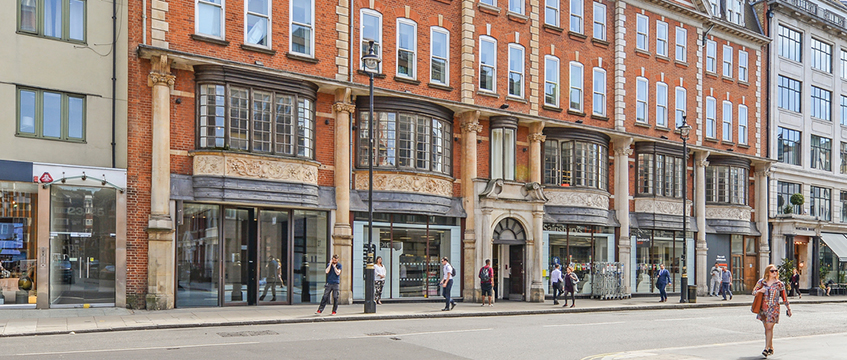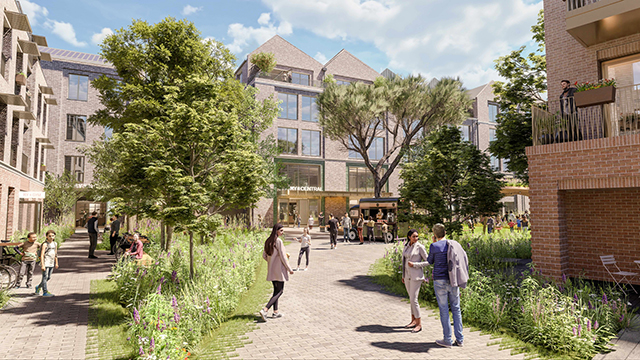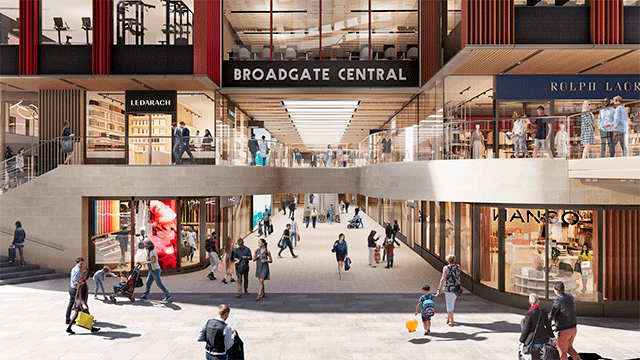It has been a long wait for Peterborough but, 15 years after the old development corporation wound up, a new masterplan is getting under way. Peterborough city council’s 20-year vision – a £900m plan covering 540 acres of the city centre – will add 1.5m sq ft of retail space, 100,000 sq ft of offices and 2,000 houses in a bid to move Peterborough up the desirability stakes and out of the top 20% of deprived areas in the UK.
Despite complaints from locals that little progress has been made in the 18 months since the masterplan was unveiled, the foundation stones are being put in place. The ODPM this month formally announced the formation of Peterborough’s urban regeneration company.
At the end of January, Morley Hammerson signed heads of terms with the council to redevelop NorthWestgate – a retail-led, 600,000 sq ft mixed-use scheme adjacent to the station, rejuvenating Peterborough’s small, tired retail offering. In addition, a bidder for the £450m PFI contract to rebuild the local NHS Trust hospital will be selected imminently. Relocation of the hospital will begin at the start of next year, opening up a site to the west of the city for residential use.
Masterplan
Liz Wade, head of the city council’s regeneration team, says Peterborough has “grown into a doughnut” – a result of office occupiers opting for out-of-town locations and the associated parking. “The masterplan,” she says, “is a chance to put some jam back into the middle.”
But there is plenty of sour to go with the sweet. Redevelopment of the railway station remains uncertain, with the council plans hamstrung between the government, Network Rail and GNER. Balancing the developer’s returns with tenant mix in the retail core remains a headache. And market appetite for office development remains questionable, with the city still struggling to soak up massive oversupply built in the 1980s.
Development has dwindled as office rents have stagnated to £8 per sq ft. With the ODPM considering ruling out the East of England for any Lyons relocations, the question remains whether the city can cope with the explosion of development planned by the council.
Morley Hammerson’s £250m NorthWestgate scheme has been the first to test local sentiment. The 20-acre site will add 500,000 sq ft of retail to the city centre and will link to the 750,000 sq ft Morley-owned Queensgate centre, which will also be refurbished.
Julian Wells, development director at Hammerson, says it is now in the process of “getting its ducks in a row” with the council, with the hope of submitting a planning application in the summer. Construction will start in 2007, with completion scheduled for 2010.
There is little doubt that a retail revamp is needed. Peterborough ranks 41 in Experian’s retail rankings, losing around a third of its trade to neighbouring centres such as Nottingham, Cambridge and even London. It also struggles to attract trade into the city, says Patrick Gray of Experian. “It has an unglamorous appeal and a rural – so less populated – catchment, especially to the north-east,” he says.
Morley Hammerson’s plans will help, believes Gray. “We would expect to see Peterborough move up the ratings into the low 30s and, although we don’t see a particularly large increase in overall draw, we see an increase in depth or penetration of the existing catchment area, and Peterborough establishing its regional dominance.”
Public consultation
Public consultation documents published this week issued a resounding approval for the scheme. But while the PR battle may have been won, Morley Hammerson still has some to convince. Signing the development agreement, councillors voiced concerns that a “good mix of shops” would be included in the scheme, not just chain stores. And others in the property industry agree.
“When nearby Queensgate shopping centre was built in the early 1980s, it killed the city centre,” says Julian Welch, associate director at Lambert Smith Hampton. “NorthWestgate needs to be a mix of large and small to reflect the traditional high street. But Morley Hammerson wants the likes of French Connection – it does not want Mr Abdul, the corner shop.”
Hammerson stands firm on its strategy to put in a mix of middle- to upper-market operators. Wells says the scheme will have a similar flavour to those developed by the group in Leicester and Bristol, where anchors include Waterstone’s, Debenhams and Rackhams.
“The comments made by councillors were good,” he says, “but there is a great opportunity for those retailers to go into adjoining streets like Westgate, and rediscover the arcades that feed back into the Queensgate.”
Rent levels will help ensure this. Rents charged in NorthWestgate will be similar to Queensgate, says Wells, and are widely believed to be in the region of £200 per sq ft zone A — double those for units on Bridge Street. “There is no doubt we are likely to get higher rents,” he says, “but the fantastic, quirky retailer wouldn’t fit into NorthWestgate.”
The prospect of rental growth in Peterborough can be no bad thing. Steve Hawkins, director at Barker Storey Matthews, says zone A rents in Bridge Street were £70 per sq ft in the early 1980s. “Now they are £100 per sq ft. That’s not good for 20 years’ growth,” he says.
Things are not much better in the office market, Hawkins explains, with rents of £10-£12 per sq ft virtually stagnant since the recession in the mid 1990s. “Unless rents reach £14-£15 per sq ft, it is difficult to justify development because construction costs just keep on rising,” he adds.
But Gloria Milne, chief executive at the Greater Peterborough Investment Agency, adopts the “build and they will come” approach. “Office space is a challenge, and we have just finished soaking up the huge glut of space built by the Peterborough development corporation,” she admits. “But none of the office space in the city centre is adequate for modern businesses.”
Milne says changing this is vital to attracting inward investment to expand the city’s established insurance sector, nurture the fledgling environmental services base, and place the city in line to get its own university.
But Richard Dade, partner at Dickens Watts & Dade, thinks such a long-term approach could be at the expense of short- to medium-term growth. He points to Orton council – a Peterborough suburb – which has just lodged a detailed planning application to expand the 120,000 sq ft town centre by 79,000 sq ft.
“Places like Orton and Breton are desperate to get on with development,” says Dade. “But we are competing with the city centre, and planners are not enthusiastic. The centre is going to be blighted for a few years, so let’s get on with other areas.”
Wade dismisses the accusation, saying the council has already worked hard to unlock the refurbishment of Orton and is supporting phase II in Breton. But she warns: “We do need to keep the jam in the middle of the doughnut to make the whole thing edible.”
|
|
|
Investment hit new highs in the east of England last year, reaching the £1.4bn mark. And increasingly it is not just owner-occupiers that are interested in the region, with 80% of sales in the past year undertaken by institutions. Patrick McMahon, partner at London-based investment agency Bidwells, says: “Funds have allocated a pool of money for this part of the country, and we have worked up a shopping list.” McMahon’s colleague, Saul Western,points to St Andrews House, Cambridge, as proof of investors’ appetite. This hit the market at the “worst possible time”, says Western,but sold incredibly quickly for £13.75m toAXA Sun Life. Retail remains investors’ prime focus, with the highest price in the region paid for Cambridge retail park. Merrill Lynch sold the remaining 50% of the park to Henderson, which already owns the remaining half, for £110m – representing a yield of 5.25%. In general, Bidwells places retail yields around the 4.25% mark, hardening to 4% over the next year. Office yields will also strengthen from an average of 6.75% last year, moving to 6% over this year. Lack of stock is set to drive the market. Spenders will include UBS, which McMahon believes has “a lot of money to spend”, as well as Deutsche and Schroders. He says: “There are a number of more traditional investors out there, like Legal & General, but they just aren’t as aggressive at the moment.” |
|
|
|
Retail ● Zone A £130-£140 per sq ft (rising to £180-£190 in Queensgate) ● 4-5% rental rise expected in the next year, in line with inflation Offices ● £8-£10 per sq ft in the city centre, rising to £13-£14 per sq ft out of town ● Little prospect of rental growth Industrial ● Rents £4.75 per sq ft, rising to £7 per sq ft for a smaller unit, but supply of land is constricting new-build ● ProLogis has submitted a planning application for 800,000 sq ft scheme at Hampton |










